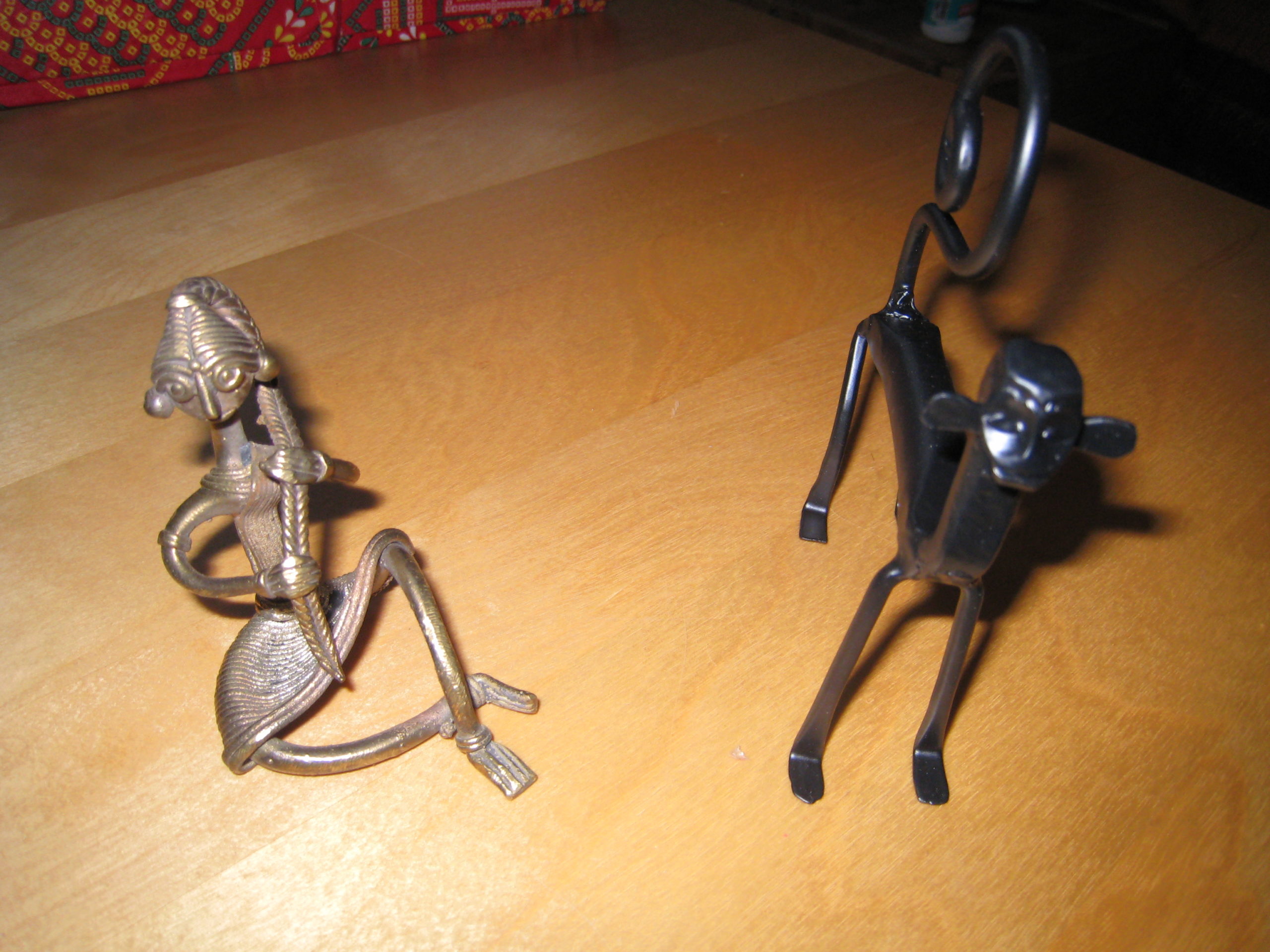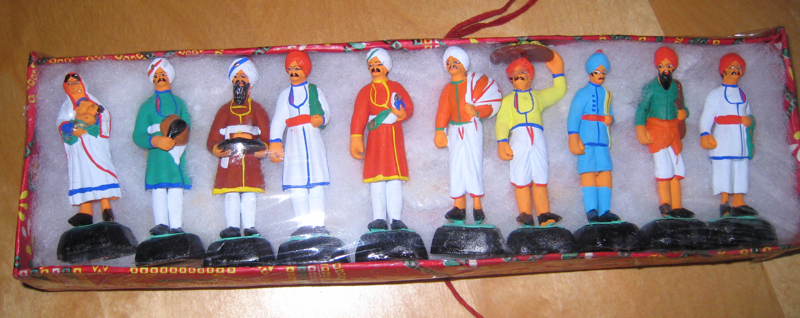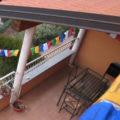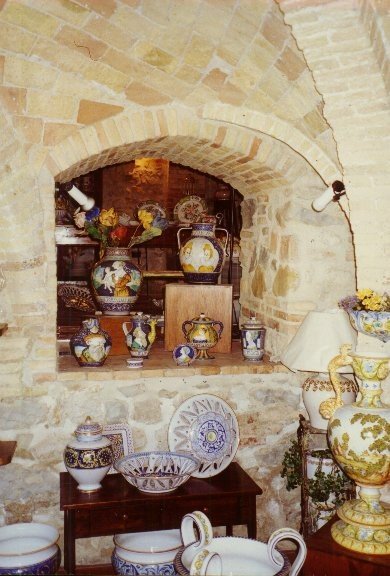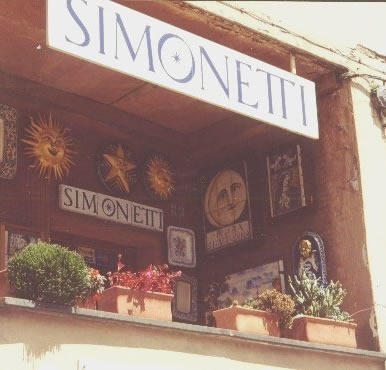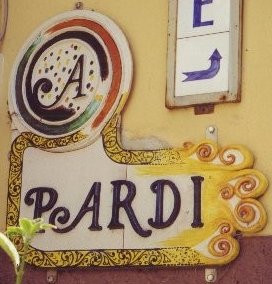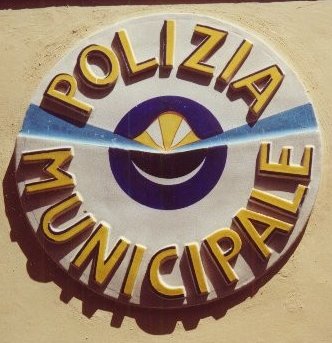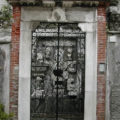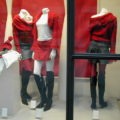Sunday, my last day in India, I hired a car to go into central Delhi, where I visited the Crafts Museum (on the advice of friend and commenter Alice). The collection is very interesting, some of it so beautiful and well made that I had to wonder where one draws the line between “handicrafts” and “fine art.” Explanations were of variable quality – some very enlightening, others non-existent. Poor lighting made it hard to really appreciate some of this fine work, sadly, especially the textiles – and I do love textiles, though I was already overwhelmed by many days of shopping for saris.
When you finish with the museum part, there’s a small courtyard surrounded by booths selling more crafts, some quite good, and the usual dance troupe – seems to be the same family, and certainly the same style, as employed at Dilli Haat.
There is also a museum shop, featuring a clutter of stuff from all over India that you might not easily find elsewhere. I loved the wrought-iron works by tribals from Madhya Pradesh (which I recognized thanks to a placard I had seen in the museum – the shop is devoid of explanation). These pieces feature delicate dancers in a style reminiscent of Native America’s Kokopeli. Human and animal figures are arrayed to form window gratings and other objects unfortunately too large and heavy to take home this trip. Someday. I did buy a little monkey, and another statuette whose provenance I know nothing about (pictured above).
I also bought a collection of plaster figurines from Bengal. I’ve seen these for years at the Central Cottage Industries Emporium in Delhi – and much better ones years ago in Calcutta – but always wondered about them because they seem too breakable to be kids’ toys, yet not artsy enough to be intended as decoration. But, thanks to another helpful museum placard, I now may have an explanation for them – somewhat different from the explanation I’d found for some similar figures at the Folk Art Museum in Santa Fe.
One big glass case in the Crafts Museum holds an entire miniature village, bustling with equisitely detailed and realistic clay figures (about 6″ tall), painted and dressed in real cloth. The attached placard explained that this was the work of a group of clay artisans originally famed for their representations of Hindu deities. The British in India, uninterested in gods, instead encouraged the sculptors to represent real Indian people of all sorts and professions, as souvenirs the Brits could take home to illustrate life in India to their untravelled friends and relatives.
My guess is that the set of figurines I bought is based on pieces originally intended to illustrate the staff of a typical British household in the Raj era, though this modern version makes a few subtle (or sloppy) changes. Let’s see whether we can figure out who all these people are.
From the left:
- The ayah (nanny) who would have looked after the British family’s children, though here she’s shown breast-feeding a child. This is confusing. She would not have been taking care of her own child while in the employee of a British household, but in all my readings about the Raj, I never heard of a “native” wet-nursing a white child. Hmm.
- The valet – you can’t tell in this picture, but he is brushing a classic sola topee (pith helmet), though it’s the wrong color here.
- Cook. Judging by the beard, he is probably Muslim – the preferred religion for cooks as they did not object to cooking meat (except pork).
- Guy #4 may be some sort of general cleaner – is that green thing over his shoulder a dustcloth?
- Guy #5 has books under his arm – the kitmadgar (butler) coming to do the household accounts with memsahib?
- The big bundle of cloth over his shoulder indicates that this is the dhobi – laundry man. There are still plenty of these around, and they still carry your clothing the exact same way.
- Greengrocer, carrying his wares on his head. It’s still possible in India today to have groceries (and many other things) delivered to your home.
- This guy is wearing some kind of uniform; he may be a watchman (chowkidar).
- Another probable Muslim carrying a possible leather bag over his shoulder – bhishti (water carrier)?
- The last one on the right has a piece of clothing over his arm – probably the darzi (tailor), who would come to your house to sew your clothes. This, too, still happens – during a visit to Midlands, the girls’ dorm at Woodstock, I saw the darzi sitting in the lounge with his sewing machine, where girls brought him clothing for minor repairs or alterations.
any thoughts on this? I could be wrong about all of it!

